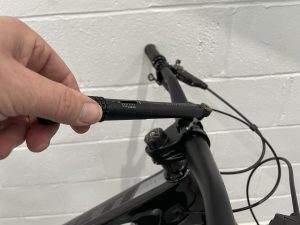Rocky Mountain’s latest Slayer eats trails for tea and cleanses its palate with boulders and rubble
Rocky Mountain Slayer 770 MSL (2017) first ride
Need to know
- With 170mm up front and 165mm rear travel, the new Slayer is designed to excel on chairlift-assisted trails
- New full carbon frame design featuring Rocky Mountain’s Ride-4 adjustable geometry system
- Boost frame designed with clearance for both 27.5in and 26 Plus wheel systems
- Four frame sizes
After a three-year hiatus, Rocky Mountain’s legendary Slayer all-mountain rig is back to bridge the gap between the Altitude and the Maiden.

The new full carbon frame is a total redesign that promises to uphold the Slayer’s original trail-crushing credentials, but given that it casts a similar shadow to the Maiden, it’s clear that going downhill fast is high on this 165mm Enduro bike’s checklist.
And what better place to put it to the test than a Top of the World run at the launch in Whistler? Other than checking the sag and tyre pressures, I didn’t spend too much time setting up the Slayer, but within the first few minutes of the descent the bike felt like I’d been riding it for months.

Internal routing keeps the front end neat and sweet
The longer front end and slack 64.7° head angle coupled with its super-low bottom bracket height and big suspension numbers make the Slayer feel almost like a downhill bike. As such, it could really be thrown into the roughest situations with reckless abandon and still hold its own.
At one point — way off line — I had to aim the bike at some ugly square-edge boulders. The Slayer simply shrugged them off as if they weren’t there and just kept motoring ahead.
There were several short technical climbs on the descent too, and the Slayer’s pedalling prowess was really highlighted here. Whether sat in saddle, or stood up cranking, the bike never felt baggy or squatted too far into its travel — a feeling that encouraged me to power, rather than spin, up the climbs. This was even more surprising, considering I had the bike set up with almost 40 per cent sag in the rear, knowing we were taking the gondola up.
Couple this pedalling efficiency with the relatively steep 73.7° seat angle and the Slayer can take you everywhere. Perhaps not trail-fast on the ups, but it’s going fast on the downs and that’s the fun part, right?
It looks fast and efficient, too, with its unique blind-sided pivots, designed to reduce the overall width of the rear end, and eliminate heel rub with the wider Boost dropout spacing. Factor in the sleek carbon rocker-link, and the Slayer is every bit as easy on the eye as it is to ride.
Rocky has steered away from bushings in the suspension pivots, instead fitting a full complement of sealed cartridge bearings. You’ll also find bearings in the top shock mount, raising rear suspension sensitivity further with the focus on improving longevity too.
After one day on the Slayer I was blown away with how capable it was and it certainly brings a whole new level of meaning to the all-mountain designation. In fact, it’s in the biggest mountains where it truly belongs. It’s basically a mini downhill bike, built to tackle the nastiest of trails.
I’m not convinced it would be my first choice for a race with a four-hour climb, but then Rocky already has the Altitude for that.

Recalibrate the geometry for a personalised ride
Ride-4 adjustable geometry
The Slayer gets Rocky Mountain’s Ride-4 adjustable geometry system. It’s a simplified version of the Ride-9 design, found on other models in the range, and creates four different mounting positions for the shock’s lower eyelet.
Riders can fine-tune the Slayer to their needs with just over a degree of adjustment in the head angle (64.7°-65.8°) and seat angle (73.7°-74.8°). The bottom bracket height can go up or down by 7.5mm, providing a true low or high setting.
Best of all, tuning the geometry has little effect on the leverage rate curve, so the rear suspension doesn’t need tweaking every time you make a change.

Range-topping 790MSL gets Fox suspension
















